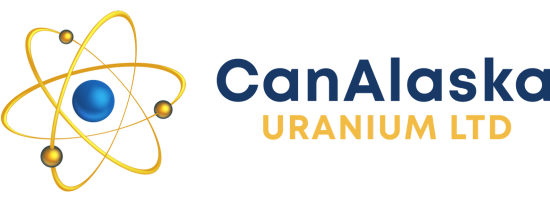Vancouver, British Columbia — November 26th, 2007: CanAlaska Uranium Ltd. (TSX-V: CVV) — The Company is pleased to report on the first assay results from exploration samples on the Grease River Project. There are extensive areas of high to very high uranium in lake sediments, as well as rock samples to 1.79% uranium in surface boulders.
The current work, financed under the Uranium Prospects plc / Yellowcake plc agreement, and operated by CanAlaska under the direction of Dr Karl Schimann, combines airborne surveys with ground prospecting and mapping. The project area covers an extensive belt of uranium showings adjacent to the northern edge of the Athabasca Basin. Regionally, this area had been defined by the Geological Survey of Canada as having a belt of high Uranium-Thorium and uranium anomalies in lake sediments. The 2007 summer program re-sampled and in-filled missing lake sediment sample locations. The very high uranium values (up to 1,870 ppm U) reported in historical lake sediment samples have been confirmed. The first batch of 63 rock samples and 13 soil samples (duplicates of historical mineralization) submitted to the laboratories confirmed the presence of uranium mineralization hosted in basement rocks and basement derived boulders in two distinct areas, west and north of Tait Lake.
Rocks in the north and west Tait Lake area consist of biotite-quartz-feldspar and amphibolitic paragneiss that have been intruded by white to pink medium-grained granitic rocks. Both of these rock units are crosscut by coarse-grained feldspar-quartz pegmatites. The paragneiss and granitic rocks contain crosscutting clear to smokey gray quartz veins and veinlets; with occasional weak to moderate hematite alteration occurring within healed fractures and along grain boundaries. The granitic rocks exhibit a weak to moderate foliation. The feldspar-quartz pegmatites are massive, white to pale pink in colour and are in sharp contact with the paragneiss and granite. Boulders and boulder fields within this area are derived from both the paragneiss and granitic rocks.
CanAlaska considers the project area to have potential for both basement-hosted unconformity deposits as well as bulk tonnage “Rossing” style deposits. The extensive nature of the uranium mineralization in lake sediments and the early success of the regional reconnaissance style exploration, provide strong indications for the future definition of drill targets from the summer campaign. The basement rocks in this area are interpreted to have been stripped of any overlying Athabasca sandstone, exposing structurally controlled uranium replacement zones, as well as possible larger tonnage intrusive related targets. The Grease River project area is easily accessible by air from the road-head and airport at Stony Rapids, Saskatchewan, located to the southeast of the project area.

Lake Sediment Sampling
The Grease River claims were staked over combined lake sediment and airborne survey radiometric anomalies straddling major geological domain boundaries, including the Grease River Shear Zone (see insert location map). The area is known for very high uranium in lake sediments (over 1,500 ppm U) as well as several in-situ uranium showings with values up to 1.6 % U3O8.
CanAlaska’s staff previously sourced and reviewed extensive historical exploration data for the region. In 2007, significant lake sediment sampling was performed over most of the Project to cover areas not previously surveyed in addition to several hundred validation samples in areas of historical anomalies.
Tait Lake Area
The area contains numerous zones that yield radiometric readings of 300 to 2,500 cps from uranium mineralization hosted within medium-grained granite and coarse-grained quartz-feldspar pegmatitic dykes that crosscut biotite-quartzo-feldspathic to biotite-quartz-feldspar amphibolitic gneiss. These uranium bearing dykes, and the local structures they are associated with provide the focus in our exploration for bulk-mineable targets. The highly elevated uranium content in the lakes along a north trending belt (see hatched area on map), reflects these zones, as well as probable further uranium mineralized zones. Sampling was carried out in a number of these areas to establish absolute uranium values, as well as identifying associated trace element geochemistry. Two of these zones are accounted for with the current samples: a) in the north Tait Lake area with boulder samples DBM054 (0.31% U3O8), DBM055 (1.79% U3O8), OM347 (0.33% U3O8); and b) in the west Tait Lake area by samples DBM060 (0.11% U3O8), DBM061 (0.12% U3O8), JR303 (0.10% U3O8), OM354 (0.11% U3O8), and outcrop samples OM353(0.08% U3O8) and OM352 (0.18% U3O8), as shown in the following table.
Table 1.North and West Tait Lake: Initial Rock Samples, Uranium Content ‘
‘
All of the samples from the current program were submitted to one of two qualified Canadian Laboratories for analysis. Samples submitted to Saskatchewan Research Laboratories were analyzed for multi-element geochemistry and including uranium by tri-acid digestion and ICP. Samples submitted for assay for trace element geochemistry to Acme Laboratories in Vancouver BC, were analyzed by aqua regia digestion and ICP analysis. The samples were collected by CanAlaska field geologists under the supervision of Dr. Karl Schimann and were shipped in secure containment to the laboratories noted above.
The Company is now progressively receiving assay information for several hundred more samples submitted for laboratory analysis during the remainder of the summer campaign. Further results for work carried out from August-October are expected over the next months. The awaited samples are from other surface mineralized zones on this and other CanAlaska projects as well as from the Company’s summer drill programs. The laboratory delays have been significant, but results will be released as they are received and evaluated.
Summary
The 2007 exploration programme is now demonstrating, through anomalous rock assay results, the high potential of the Grease River Project for uranium. The sample results confirm the strong uranium enrichment in the lake sediment and soils of the area, indicating a regional uranium enhancement and high uranium mobility. This constitutes a very favourable environment for hydrothermal and structure-related enrichment, such as found within the basement in the Eastern Athabasca Basin (Eagle Point, Millenium). The Tait Lake mineralization, as characterized by the two sets of samples analysed to-date, suggests that uranium mineralization present within the rocks of the Tait Lake area has been mobilized through weathering processes and concentrated within the lake sediments and soils. This further suggests that there is a strong possibility of uranium mineralization being concentrated within fractures forming vein-like deposits.
The Company expects to receive numerous more assay results from Tait Lake and nearby areas on the project over the coming months. These results will form the basis for more detailed exploration in 2008.
The person responsible for this release is Peter Dasler, M.Sc., P. Geo. President of CanAlaska Uranium Ltd.
About CanAlaska Uranium Ltd. — www.canalaska.com
CANALASKA URANIUM LTD. (CVV — TSX.V, CVVUF — OTCBB, DH7 — Frankfurt) is undertaking uranium exploration in seventeen 100%-owned and two optioned uranium projects in Canada’s Athabasca Basin. Since September 2004, the Company has aggressively acquired one of the largest land positions in the region, comprising over 2,500,000 acres (10,117 sq. km or 3,906 sq. miles). CanAlaska has expended over Cdn$24 million exploring its properties in the Athabasca Basin and has delineated multiple uranium targets. Initial drilling results from the West McArthur Project revealed uranium mineralization and significant zones of hydrothermal alteration, indicative of a favourable environment for uranium deposition. Active drilling and exploration has continued through the Summer, and Fall 2007 seasons at West McArthur and at 2 other significant projects. The Company’s high profile in the prominent Athabasca Basin has attracted the attention of major international strategic partners. Among others, Mitsubishi Development Pty., a subsidiary of Japanese conglomerate Mitsubishi Corporation, has undertaken to provide CanAlaska C$11 mil. in exploration funding to earn 50% of the West McArthur Project. A C$19 mil. Agreement for exploration has also been executed with a Korean Consortium led by Hanwha Corporation to enter into joint exploration of CanAlaska’s Cree East Project.
About Uranium Prospects Plc – www.uraniumprospects.com
URANIUM PROSPECTS PLC (PLUS:URPP) was floated on PLUS in London in July 2007. The Company was established to acquire, or purchase options to acquire, exploration rights over land where initial tests have indicated the potential for a high concentration of uranium deposits, either on its own or under a joint venture arrangement.
In early August 2007 the Company acquired the option to purchase a 51% stake in a joint venture company with CanAlaska Uranium Ltd (40%) to own the Grease River Project. It acquired the interest from Yellowcake Plc (PLUS: YEL) (9%) and has assumed a financial commitment for the project.
Enquiries:
Mark Watson-Mitchell, Chairman
Email: mark@uraniumprospects.com
Tel: 0044 (0)207 638 8750
About Yellowcake Plc – www.yellowcakeplc.co.uk
YELLOWCAKE PLC (PLUS:YEL) is the world’s first portfolio company specialising wholly in investing in uranium explorers, developers and producers. Founded in February 2005, it floated on London’s PLUS Market in July 2005. Yellowcake commenced investing in quoted and unquoted uranium companies in late September 2005 and currently its portfolio includes 32 companies, with operations in Africa, Australia, Canada, Kazakhstan, Mongolia, Paraguay and the United States. Its strategy also includes sourcing uranium projects and it has a 9% carried interest in the Grease River Option Agreement with CanAlaska (40%) and Uranium Prospects (PLUS: URPP) (51%).
Enquiries:
Robert Wallace, CEO
Email: robert@yellowcakeplc.co.uk
Tel: 0044 (0)7970 648480
On behalf of the Board of Directors
“Peter Dasler”
Peter Dasler, P. Geo., President & CEO
Investor Contact: Emil Fung, Vice President, Corporate Development
Tel: +1.604.688.3211 Toll Free (North America) 1-800-667-1870 Email: info@canalaska.com
The TSX Venture has not reviewed and does not accept responsibility for the adequacy or accuracy of this release: CUSIP#13708P 10 2.
This news release contains certain “Forward-Looking Statements” within the meaning of Section 21E of the United States Securities Exchange Act of 1934, as amended. All statements, other than statements of historical fact, included herein are forward-looking statements that involve various risks and uncertainties. There can be no assurance that such statements will prove to be accurate, and actual results and future events could differ materially from those anticipated in such statements. Important factors that could cause actual results to differ materially from the Company’s expectations are disclosed in the Company’s documents filed from time to time with the British Columbia Securities Commission and the United States Securities & Exchange Commission. Not to be construed as an offer to buy or sell securities of CanAlaska Uranium Ltd.

